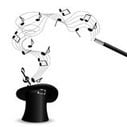What is, "Big Sound"?
As many say, when you experience "big sound", you know it ... ![]() . Not equivalent to loudness, though the volume setting is part of the equation - a pretty good description of various aspects is here, https://forums.stevehoffman.tv/threads/what-does-big-sound-mean-to-you.1157065/#post-30558048.
. Not equivalent to loudness, though the volume setting is part of the equation - a pretty good description of various aspects is here, https://forums.stevehoffman.tv/threads/what-does-big-sound-mean-to-you.1157065/#post-30558048.
The above link alone says that this is not an "impossible dream!" - people have achieved this regularly, pretty well since the birth of audio recordings, using various methods. A key part of this, is that is often done using physical big speakers, so one of the myths of the audiophile world is that humongous speakers are a necessary ingredient ... but are they really? Also, that enormous power is needed, thousands and thousand of watts - umm, drop a Marshall guitar amp into your lounge, a few feet way, with its miserable 60 watt tube amp, and have a decent player give it a solid workout - was that, err, a small sound? Or, did it blast you, with intensity? ![]() ... What matters, as always, is the integrity of the playback chain - get it right, and big sound emerges; get it wrong, and you won't ...
... What matters, as always, is the integrity of the playback chain - get it right, and big sound emerges; get it wrong, and you won't ...
The two essentials are that the system can produce realistic sound levels, and, that at this level that distortion is under control - the latter is something that the audio world still struggles to achieve. The latest hifi show I visited demonstrated that quite significant gains have been made over the last decade, in that the general standard is much higher; you can now buy a combo of gear at something approaching sensible pricing that gets things right, in the ball park of always being able to produce, "big sound".











3 Comments
Recommended Comments